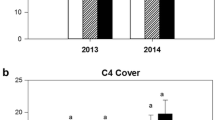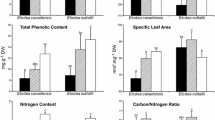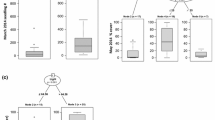Abstract
Biological invasions in wetlands by Water Primroses (Ludwigia grandiflora ssp. hexapetala and L. peploides ssp. montevidensis) are an increasing problem especially in wet meadows. The aim of this paper is to quantify differences between species and the adaptation of these amphibious plants in order to establish the consequences for site managers. The hypotheses were: (i) that these species differ in biomass and morphology, and (ii) that terrestrial habitats determine particular adaptations such as reduced biomass, more roots and a bushy form. Biomasses from five sites were collected, following seasonal changes and biological traits were measured on selected plants. Comparing species in aquatic habitats, L. peploides produced less biomass than L. grandiflora. Comparing habitats for L. grandiflora, the biomass in meadows was almost twice that in dykes, particularly due to old stems, the converse of the hypothesis. Terrestrial forms were characterized by a bushy morphology, with shorter internodes and stems, as well as more secondary ramifications, while in aquatic habitats the plant architecture was simpler. Models were built linking morphology to species, sites and water conditions. Adaptations to terrestrial habitats of a particularly resistant form with a significant potential biomass are practical constraints for farmers and managers.






Similar content being viewed by others
References
Alpert, P., E. Bone & C. Holzapfel, 2000. Invasiveness, invasibility and the role of environmental stress in the spread of non-native plants. Perspectives in Plant Ecology, Evolution and Systematics 3: 52–66.
Anderson, J. T., J. H. Willis & T. Mitchell-Olds, 2011. Evolutionary genetics of plant adaptation. Trends in Genetics 27: 258–266.
Blossey, B. & R. Notzold, 1995. Evolution of increased competitive ability in invasive nonindigenous plants: a hypothesis. Journal of Ecology 83: 887–889.
Dandelot, S., 2004. Les Ludwigia spp. invasives du sud de la France : historique, biosystématique, biologie et écologie. Thèse doctorale, sciences de l’environnement, Université d’Aix-Marseille III: 207 pp.
Davis, M. A., J. Pergl, A.-M. Truscott, J. Kollmann, J. P. Bakker, R. Domenech, K. Prach, A.-H. Prieur-Richard, R. M. Veeneklaas, P. Pysek, R. del Moral, R. J. Hobbs, S. L. Collins, S. T. A. Pickett & P. B. Reich, 2005. Vegetation change: a reunifying concept in plant ecology. Perspectives in Plant Ecology, Evolution and Systematics 7: 69–76.
Dutartre, A., J. Haury, S. Dandelot, J. Coudreuse, B. Ruaux, E. Lambert, P. Le Goffe & M.-J. Menozzi, 2007. Les jussies : caractérisation des relations entre sites, populations et activités humaines. Implications pour la gestion Programme de recherche INVABIO 2003–2006, rapport final: 128 pp.
EPPO, 2011. Ludwigia grandiflora and Ludwigia peploides Onagraceae—Water primroses. EPPO Bulletin 41: 414–418.
Grillas, P., L. Tan Ham, A. Dutartre & F. Mesléard, 1992. Distribution de Ludwigia en France. Etude des causes de l’expansion récente en Camargue. 15ème Conférence. Internationale. COLUMA—Annales de l’Association Nationale de Protection des Plantes 3: 1083–1090.
Grime, J. P. & J. M. L. Mackey, 2002. The role of plasticity in resource capture by plants. Evolutionary Ecology 16: 299–307.
Haury, J. & J.-P. Damien, 2012. Les invasions biologiques dans le Parc naturel régional de Brière : présentation d’une recherche-action. Sciences Eaux et Territoires n° spécial Invasions biologiques 06-2012: 26–33.
Haury, J., J. Coudreuse, J. Debril, B. Ruaux & A. Jigorel, 2008. The role of invasive macrophytes in Nitrogen and Phosphorus dynamics in two gravel pits, Rennes—France. Verhandlungen der Internationalen Vereinigung für Theoretische und Angewandte Limnologie (Montréal Aug. 2007) 30: 607–610.
Haury, J., F. Noël, M. Bozec, J. Coudreuse, J. Guil, G. Marrel, J.-L. Maisonneuve & J.-P. Damien, 2011. Importance of Ludwigia grandiflora as invasive weed in meadows and pastures in Western France. 3rd International Symposium on Weeds and Invasive Plants October 2–7, 2011 in Ascona, Switzerland: 5. http://www.wsl.ch/epub/ewrs/authors/detail_EN?id=139&type=authors.
Haury, J., J.-P. Damien, J.-L. Maisonneuve & B. Bottner, 2012. La gestion des Jussies en milieu aquatique et en prairies humides. In Haury, J. & R. Matrat (eds), 2012. Plantes invasives, la nécessité de différentes approches. Actes du colloque régional Les plantes invasives en Pays-de-la-Loire, 11–12 mai 2011, Angers, Terra botanica. Æstuaria, collection Paroles des Marais atlantiques: 171–189.
Hobbs, R. J. & L. F. Huenneke, 1992. Disturbance, diversity and invasion: implications for conservation. Conservation Biology 6: 324–337.
Hussner, A., 2009. Growth and photosynthesis of four invasive aquatic plant species in Europe. Weed Research 49: 506–515.
Hussner, A., 2010. Growth response and root system development of the invasive Ludwigia grandiflora and Ludwigia peploides to nutrient availability and water level. Fundamental and Applied Limnology, Archiv für Hydobiologie 177: 189–196.
Hussner, A., 2012. Alien aquatic plant species in European countries. Weed Research 52: 297–306.
Huston, A., 2004. Management strategies for plant invasions: manipulating productivity, disturbance, and competition. Diversity and Distributions 10: 167–178.
Lambert, E., A. Dutartre, J. Coudreuse & J. Haury, 2010. Relationships between the biomass production of invasive Ludwigia species and physical properties of habitats in France. Hydrobiologia 656: 173–186.
Lee, C. E., 2002. Evolutionary genetics of invasive species. Trends in Ecology & Evolution 17: 386–391.
Richardson, D. M., P. Pyšek & J. T. Carlton, 2011. A compendium of essential concepts and terminology in invasion ecology. In Richardson, D. M. (ed.), Fifty years of invasion ecology: the legacy of Charles Elton. Blackwell, London: 409–420.
Ruaux, B., 2008. Les plantes envahissantes des corridors fluviaux : traits biologiques, impacts de Ludwigia peploides et L. grandiflora en Loire moyenne et implications pour la gestion. Université François Rabelais de Tours; Pôle Universités Centre Val de Loire. Tours, Université François Rabelais: 278 pp.
Ruaux, B., S. Greulich, J. Haury & J.-P. Berton, 2009. Sexual reproduction of two alien invasive Ludwigia (Onagraceae) on the middle Loire River, France. Aquatic Botany 90: 143–148.
Simberloff, D., J. L. Martin, P. Genovesi, V. Maris, D. A. Wardle, J. Aronson, F. Courchamp, B. Galil, E. García-Berthou, M. Pascal, P. Pyšek, R. Sousa, E. Tabacchi & M. Vilà, 2013. Impacts of biological invasions: what’s what and the way forward. Trends in Ecology and Evolution 28: 58–66.
Thouvenot, L., 2012. Stratégies de réponse de l’espèce invasive Ludwigia grandiflora aux contraintes environnementales. Thèse, Université de Rennes 1—Ecole doctorale Vie-Agro-Santé, Rennes: 205 pp.
Thouvenot, L., J. Haury & G. Thiébaut, 2013a. Seasonal plasticity of Ludwigia grandiflora under light and water depth gradients: an outdoor mesocosm experiment. Flora 208: 430–437.
Thouvenot, L., J. Haury & G. Thiébaut, 2013b. A success story: water primroses, aquatic plant pests. Aquatic Conservation: Marine and Freshwater Ecosystems 23: 790–803.
Vilà, M., C. Basnou, P. Pyšek, M. Josefsson, P. Genovesi, S. Gollasch, W. Nentwig, S. Olenin, A. Roques, D. Roy, P. E. Hulme & DAISIE Partners, 2010. How well do we understand the impacts of alien species on ecosystem services? A pan-European, cross-taxa assessment. Frontiers in Ecology and the Environment 8: 135–144.
Acknowledgments
We acknowledge the site managers: Jean-Luc Maisonneuve (EDENN), Jean-Patrice Damien (PNR Brière), Nathalie Saur (GIP Loire-Estuaire), Bertrand Martin (Ville de Rennes) for their collaboration. Financial support was provided by the Direction Régionale de l’Environnement de l’Aménagement et du Logement des Pays de la Loire (Roland Matrat). We also thank students involved in data collection. We are grateful to Mrs Frances Bucquet for checking her native language English in the first version and Mrs Aldyth Nys for the revised ones. We are also grateful to the anonymous referees and the Editor in Chief for their helpful comments on different versions of the manuscript.
Author information
Authors and Affiliations
Corresponding author
Additional information
Guest editors: M. T. Ferreira, M. O’Hare, K. Szoszkiewicz & S. Hellsten / Plants in Hydrosystems: From Functional Ecology to Weed Research
Electronic supplementary material
Below is the link to the electronic supplementary material.
Rights and permissions
About this article
Cite this article
Haury, J., Druel, A., Cabral, T. et al. Which adaptations of some invasive Ludwigia spp. (Rosidae, Onagraceae) populations occur in contrasting hydrological conditions in Western France?. Hydrobiologia 737, 45–56 (2014). https://doi.org/10.1007/s10750-014-1815-7
Received:
Accepted:
Published:
Issue Date:
DOI: https://doi.org/10.1007/s10750-014-1815-7




